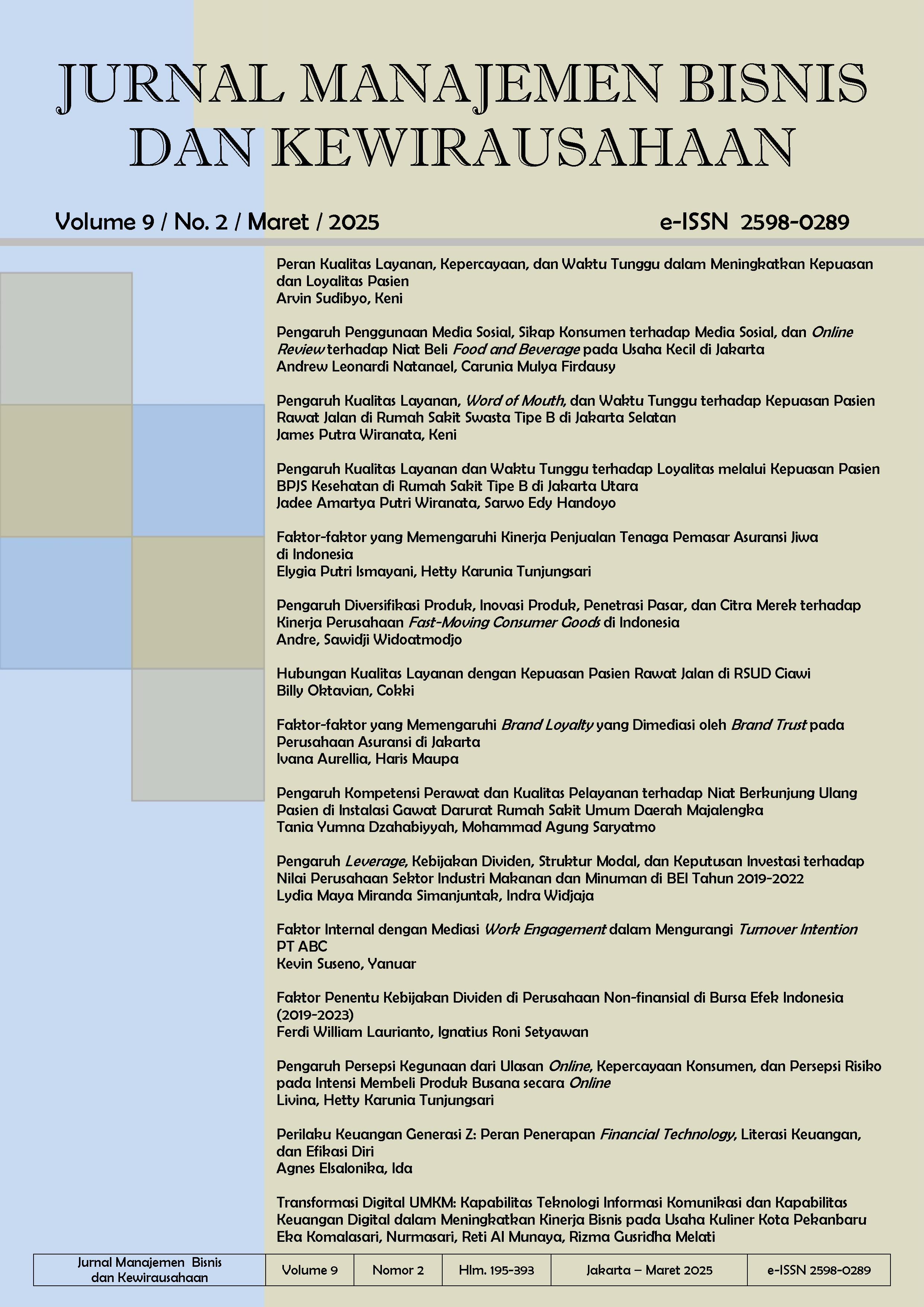Faktor-faktor yang memengaruhi kinerja penjualan tenaga pemasar asuransi jiwa di Indonesia
Main Article Content
Abstract
This study aims to determine the effect of capabilities of the sales organization on personal capabilities of salespeople and how this in turn leads to sales behavior and performance, taking into account the intensity of competition as a moderating variable. The research method employed is quantitative, utilizing a systematically distributed questionnaire through Google Forms distributed to 200 life insurance marketers. The study approach involves validity analysis, data analysis, hypothesis testing, and moderation analysis. The results of the study indicate that sales management capabilities and personal selling at the organizational level had a positive and significant effect on individual sales capabilities and customer-oriented sales behavior and sales. In addition, competitive intensity moderates the relationship between customer-oriented sales behavior and sales performance, as well as the relationship between sales-oriented sales behavior and sales performance.
Penelitian ini mengkaji bagaimana kemampuan dari organisasi penjualan memengaruhi kemampuan pribadi tenaga penjualan dan bagaimana hal ini selanjutnya menimbulkan perilaku dan kinerja penjualan, dengan mempertimbangkan intensitas persaingan sebagai variabel moderasi. Metode penelitian yang digunakan adalah kuantitatif dengan menggunakan kuesioner melalui Google Form yang disebar kepada 200 orang tenaga pemasar asuransi jiwa. Pendekatan penelitian melibatkan analisis validitas, analisis data, pengujian hipotesis, dan analisis moderasi. Hasil penelitian menunjukkan bahwa kemampuan manajemen penjualan dan personal selling di level organisasi berpengaruh positif dan signifikan terhadap kemampuan penjualan individu dan perilaku penjualan yang berorientasi pada pelanggan serta penjualan. Selain itu, intensitas persaingan memoderasi hubungan antara perilaku penjualan yang berorientasi pelanggan dan kinerja penjualan, serta hubungan antara perilaku penjualan yang berorientasi penjualan dan kinerja penjualan.
Article Details

This work is licensed under a Creative Commons Attribution-NonCommercial-ShareAlike 4.0 International License.
This work is licensed under a Jurnal Manajemen Bisnis dan Kewirausahaan Creative Commons Attribution-ShareAlike 4.0 International License.
References
Auh, S., & Menguc, B. (2013). Knowledge sharing behaviors of industrial salespeople: An integration of economic, social psychological, and sociological perspectives. European Journal of Marketing, 47(8), 1333-1355.
Baldauf, A., Cravens, D. W., & Piercy, N. F. (2001). Examining business strategy, sales management, and salesperson antecedents of sales organization effectiveness. Journal of Personal Selling & Sales Management, 21(2), 109-122.
Barney, J. B. (1991). Firm resources and sustained competitive advantage. Journal of Management, 17(1), 99-120.
Brashear, T. G., Bellenger, D. N., Barksdale, H. C., & Ingram, T. N. (1997). Salesperson behavior: Antecedents and links to performance. Journal of Business and Industrial Marketing. https://doi.org/10.1108/08858629710188018
Dibrell, C. (2007). Dynamic strategic planning: Achieving strategic flexibility through formalization. Journal of Business & Management, 13(1).
Grawe, S. J., Chen, H., & Daugherty, P. J. (2009). The relationship between strategic orientation, service innovation, and performance. International Journal of Physical Distribution & Logistics Management, 39(4), 282-300.
Guenzi, P., Sajtos, L., & Troilo, G. (2016). The dual mechanism of sales capabilities in influencing organizational performance. Journal of Business Research, 69(9), 3707-3713.
Guest, D. E. (1997). Human resource management and performance: A review and research agenda. The International Journal of Human Resource Management, 8(3), 263-276. https://doi.org/10.1080/095851997341630
Hermawan, A. (2012). Komunikasi Pemasaran. Jakarta: PT. Penerbit Erlangga.
Ingram, T. N., LaForge, R. W., Avila, R. A., Schwepker, C. H., & Williams, M. R. (2015). Sales management: Analysis and decision making. Routledge.
Jobber, D., & Lancaster, G. (2009). Selling and sales management (8th ed.). Harlow, England: Pearson Education Limited.
Kotler, P. (2000). Manajemen Pemasaran. Jakarta: PT. Prehallindo.
Mishkin, F. S. (2004). The Economics of Money, Banking, and Financial Markets (7th ed.). New York: Pearson Education.
Murray, J.Y., Gao, G.Y. and Kotabe, M. (2011), “Market orientation and performance of export ventures: the process through marketing capabilities and competitive advantages”, Journal of the Academy of Marketing Science, Vol. 39 No. 2, pp. 252-269.
Parry, S. B. (1996). The quest for competences: Competency studies can help you make HR decisions, but the results are only as good as the study. Training.
Rentz, J. O., Shepherd, C. D., Tashchian, A., Dabholkar, P. A., & Ladd, R. T. (2002). A measure of selling skill: Scale development and validation. The Journal of Personal Selling and Sales Management, 22(1), 13-21. Taylor & Francis, Ltd.
Saxe, R.; Weitz, B.A. The SOCO scale: A measure of the customer orientation of salespeople. J. Mark. Res. 1982, 19, 343–351.
Verbeke, W., Dietz, B., & Verwaal, E. (2011). Drivers of sales performance: A contemporary meta-analysis. Have salespeople become knowledge brokers? Journal of the Academy of Marketing Science, 39(3), 407-428. https://doi.org/10.1007/s11747-010-0211-8
Zoltners, Andris A dan Sally E. Lorimer, 2000,”Sales territory Alignment: An overlooked productivity tool”. Journal of Personal Selling & Sales Management, Vol.20 No.3. p.139-150.


